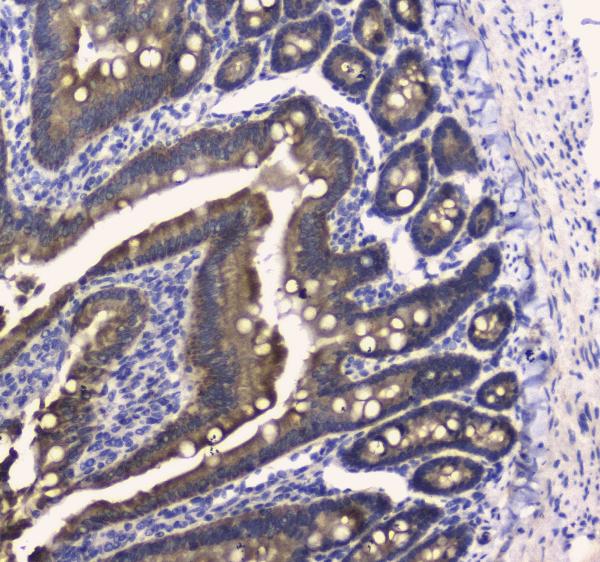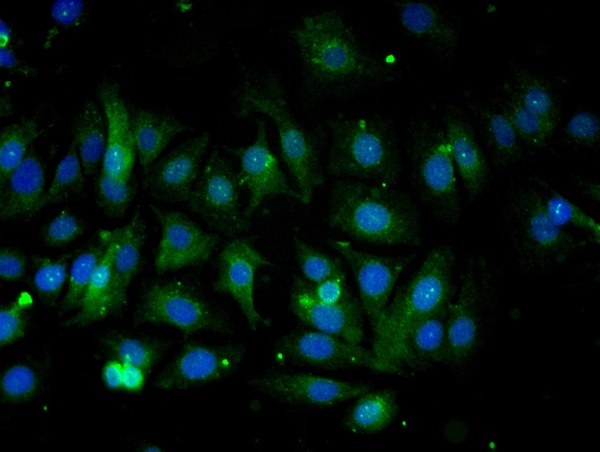COX4 antibody
GTX114330
ApplicationsImmunoFluorescence, Western Blot, ImmunoCytoChemistry, ImmunoHistoChemistry, ImmunoHistoChemistry Frozen, ImmunoHistoChemistry Paraffin
Product group Antibodies
TargetCOX4I1
Overview
- SupplierGeneTex
- Product NameCOX4 antibody
- Delivery Days Customer9
- Application Supplier NoteWB: 1:500-1:3000. ICC/IF: 1:100-1:1000. IHC-P: 1:100-1:1000. *Optimal dilutions/concentrations should be determined by the researcher.Not tested in other applications.
- ApplicationsImmunoFluorescence, Western Blot, ImmunoCytoChemistry, ImmunoHistoChemistry, ImmunoHistoChemistry Frozen, ImmunoHistoChemistry Paraffin
- CertificationResearch Use Only
- ClonalityPolyclonal
- Concentration0.42 mg/ml
- ConjugateUnconjugated
- Gene ID1327
- Target nameCOX4I1
- Target descriptioncytochrome c oxidase subunit 4I1
- Target synonymsCOX IV-1, COX4, COX4-1, COXIV, COXIV-1, MC4DN16, cytochrome c oxidase subunit 4 isoform 1, mitochondrial, cytochrome c oxidase polypeptide IV, cytochrome c oxidase subunit IV
- HostRabbit
- IsotypeIgG
- Protein IDP13073
- Protein NameCytochrome c oxidase subunit 4 isoform 1, mitochondrial
- Scientific DescriptionCytochrome c oxidase (COX) is the terminal enzyme of the mitochondrial respiratory chain. It is a multi-subunit enzyme complex that couples the transfer of electrons from cytochrome c to molecular oxygen and contributes to a proton electrochemical gradient across the inner mitochondrial membrane. The complex consists of 13 mitochondrial- and nuclear-encoded subunits. The mitochondrially-encoded subunits perform the electron transfer and proton pumping activities. The functions of the nuclear-encoded subunits are unknown but they may play a role in the regulation and assembly of the complex. This gene encodes the nuclear-encoded subunit IV isoform 1 of the human mitochondrial respiratory chain enzyme. It is located at the 3 of the NOC4 (neighbor of COX4) gene in a head-to-head orientation, and shares a promoter with it. [provided by RefSeq]
- Storage Instruction-20°C or -80°C,2°C to 8°C
- UNSPSC12352203
References
- Sun X, Sui W, Mu Z, et al. Mirabegron displays anticancer effects by globally browning adipose tissues. Nat Commun. 2023,14(1):7610. doi: 10.1038/s41467-023-43350-8Read this paper
- Lee H, Lee TJ, Galloway CA, et al. The mitochondrial fusion protein OPA1 is dispensable in the liver and its absence induces mitohormesis to protect liver from drug-induced injury. Nat Commun. 2023,14(1):6721. doi: 10.1038/s41467-023-42564-0Read this paper
- Cardile A, Zanrè V, Campagnari R, et al. Hyperforin Elicits Cytostatic/Cytotoxic Activity in Human Melanoma Cell Lines, Inhibiting Pro-Survival NF-κB, STAT3, AP1 Transcription Factors and the Expression of Functional Proteins Involved in Mitochondrial and Cytosolic Metabolism. Int J Mol Sci. 2023,24(2). doi: 10.3390/ijms24021263Read this paper
- Seki T, Yang Y, Sun X, et al. Brown-fat-mediated tumour suppression by cold-altered global metabolism. Nature. 2022,608(7922):421-428. doi: 10.1038/s41586-022-05030-3Read this paper
- Zhang Z, Yi J, Xie B, et al. Parkin, as a Regulator, Participates in Arsenic Trioxide-Triggered Mitophagy in HeLa Cells. Curr Issues Mol Biol. 2022,44(6):2759-2771. doi: 10.3390/cimb44060189Read this paper
- Tsukahara T, Sahara Y, Ribeiro N, et al. Adenine nucleotide translocase 2, a putative target protein for 2-carba cyclic phosphatidic acid in microglial cells. Cell Signal. 2021,82:109951. doi: 10.1016/j.cellsig.2021.109951Read this paper
- Chen CY, Lee DS, Choong OK, et al. Cardiac-specific microRNA-125b deficiency induces perinatal death and cardiac hypertrophy. Sci Rep. 2021,11(1):2377. doi: 10.1038/s41598-021-81700-yRead this paper
- Chou SY, Chan L, Chung CC, et al. Altered Insulin Receptor Substrate 1 Phosphorylation in Blood Neuron-Derived Extracellular Vesicles From Patients With Parkinson's Disease. Front Cell Dev Biol. 2020,8:564641. doi: 10.3389/fcell.2020.564641Read this paper
- Salman M, Tabassum H, Parvez S. Nrf2/HO-1 mediates the neuroprotective effects of pramipexole by attenuating oxidative damage and mitochondrial perturbation after traumatic brain injury in rats. Dis Model Mech. 2020,13(8). doi: 10.1242/dmm.045021Read this paper
- Tan C, Liu X, Peng W, et al. Seizure-induced impairment in neuronal ketogenesis: Role of zinc-α2-glycoprotein in mitochondria. J Cell Mol Med. 2020,24(12):6833-6845. doi: 10.1111/jcmm.15337Read this paper







![FACS analysis of K562 cells using GTX82782 COX4 antibody [6B3]. Blue : COX4 Red : negative control](https://www.genetex.com/upload/website/prouct_img/normal/GTX82782/GTX82782_20170912_FACS_w_23061322_816.webp)
